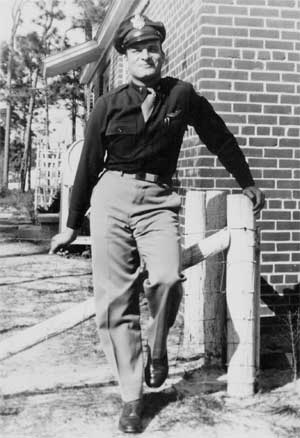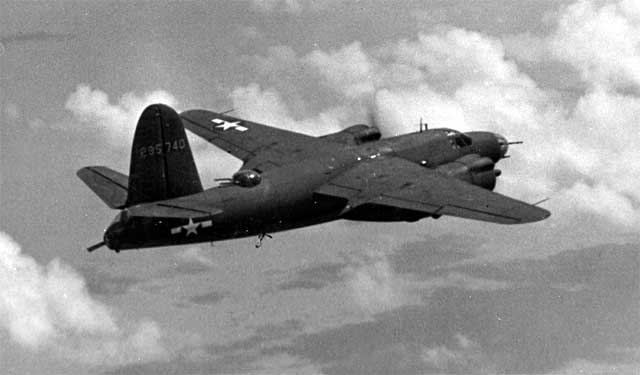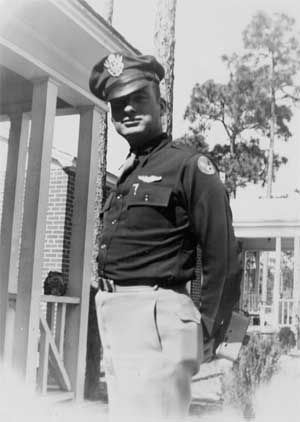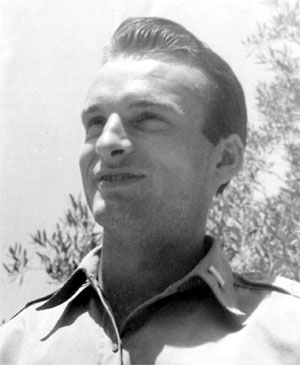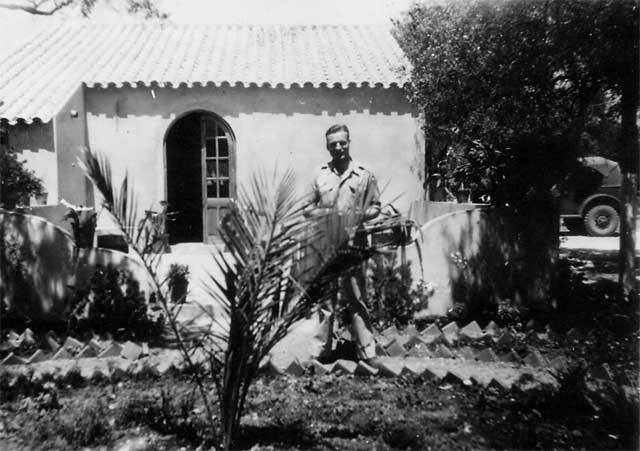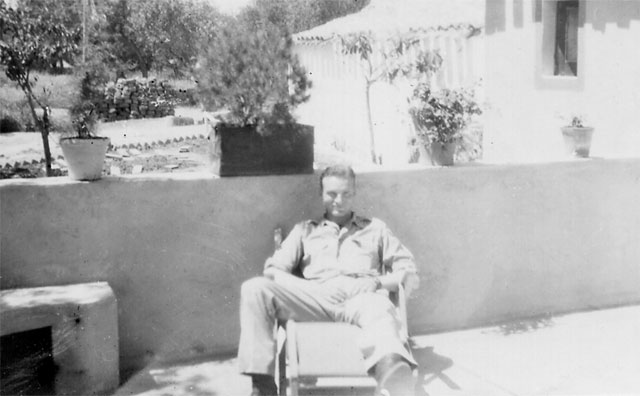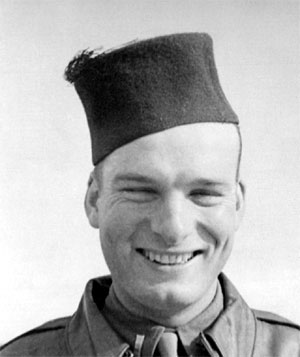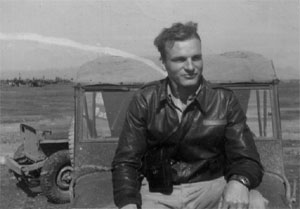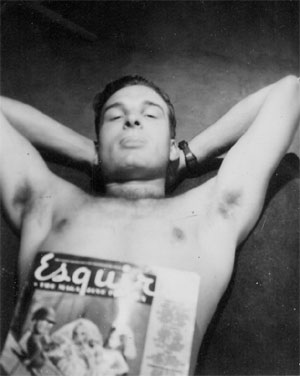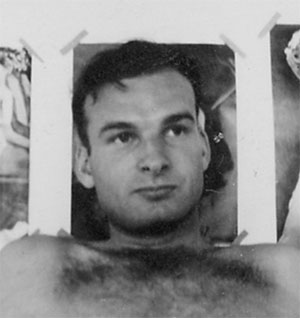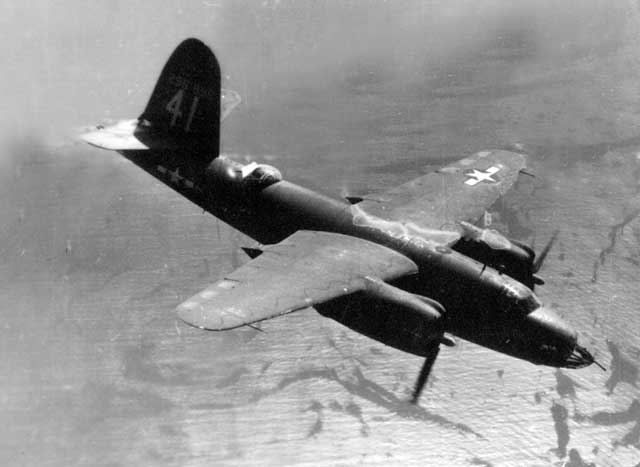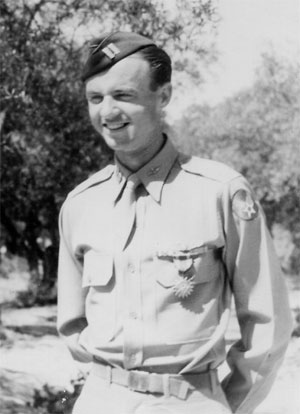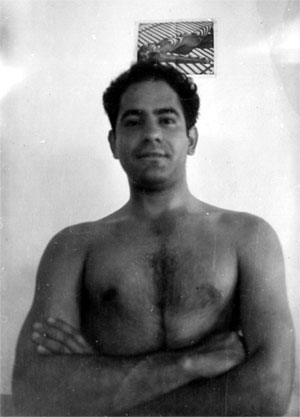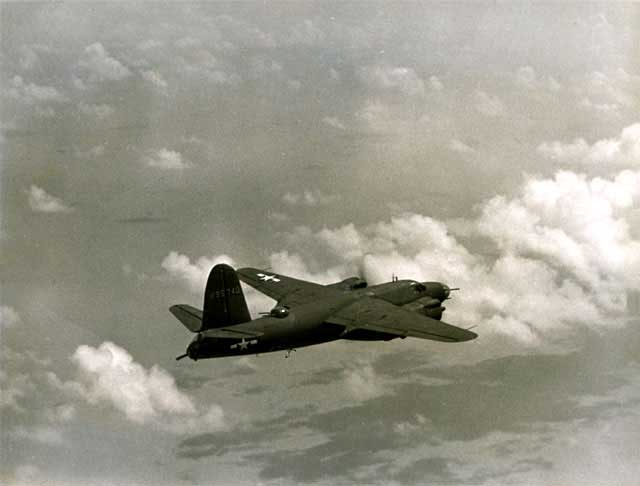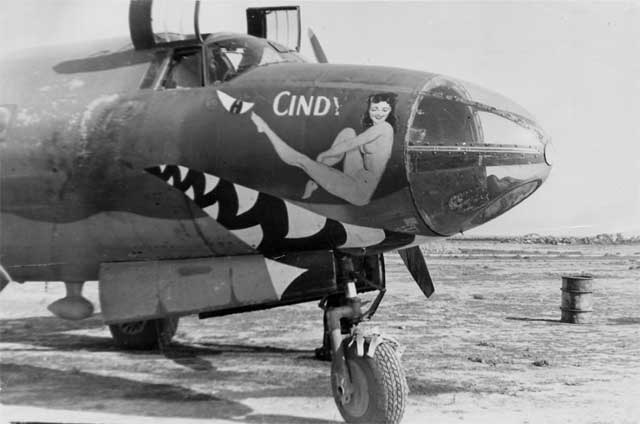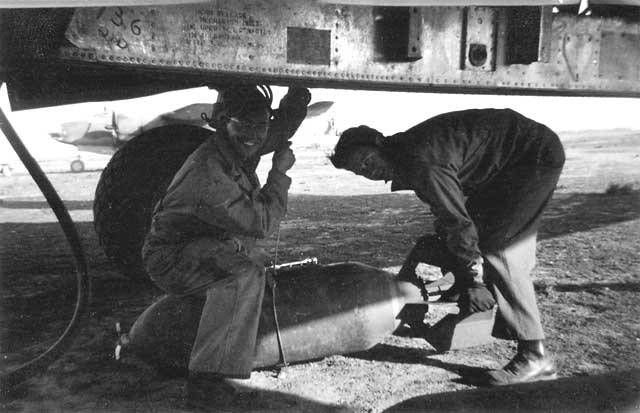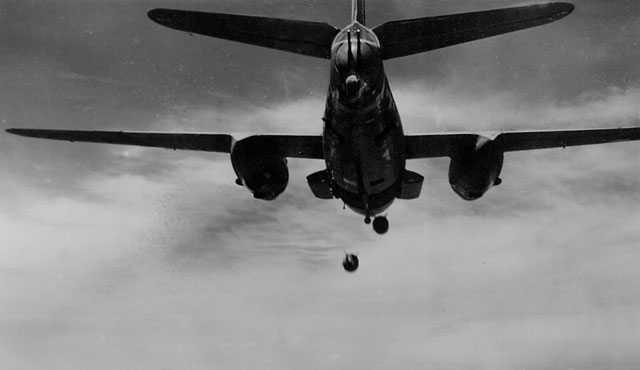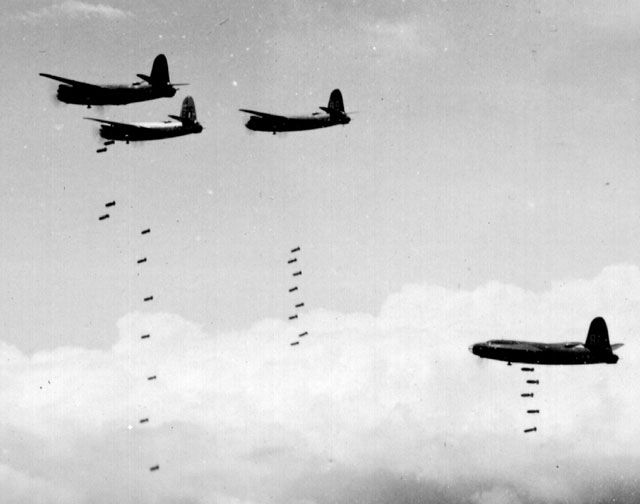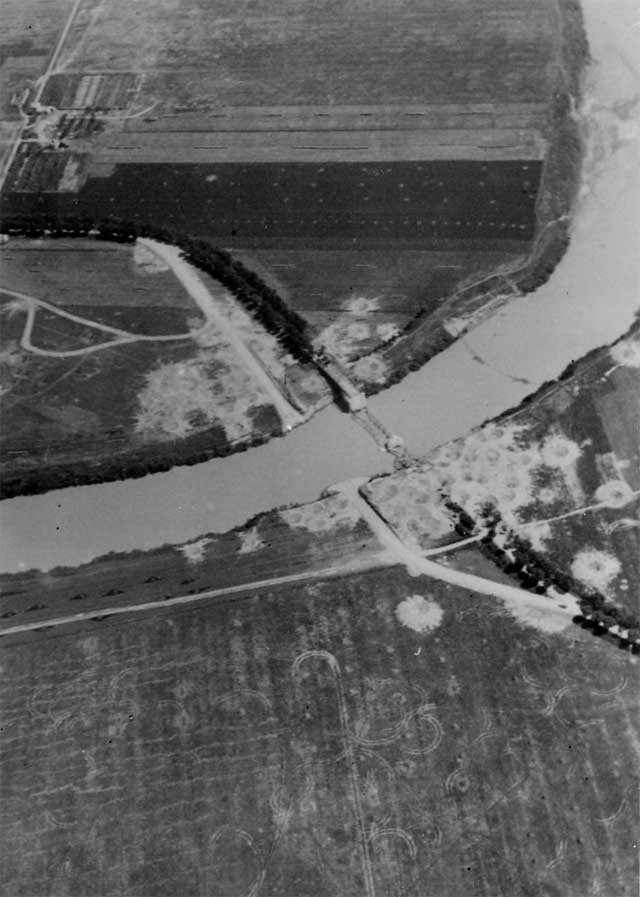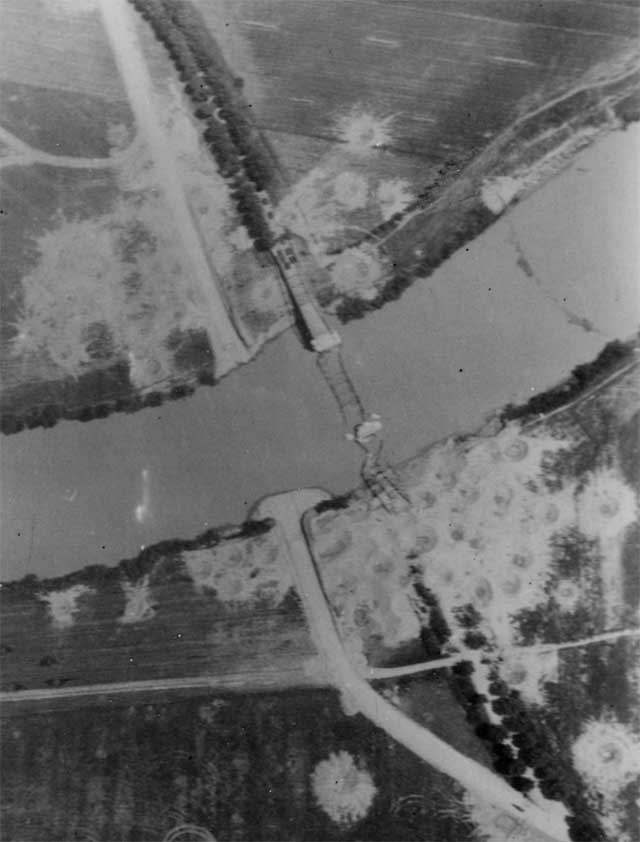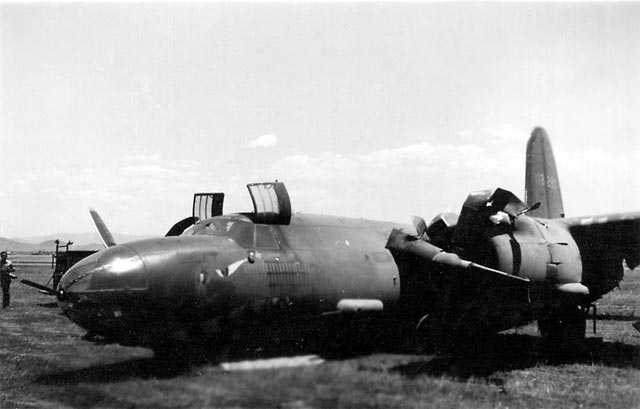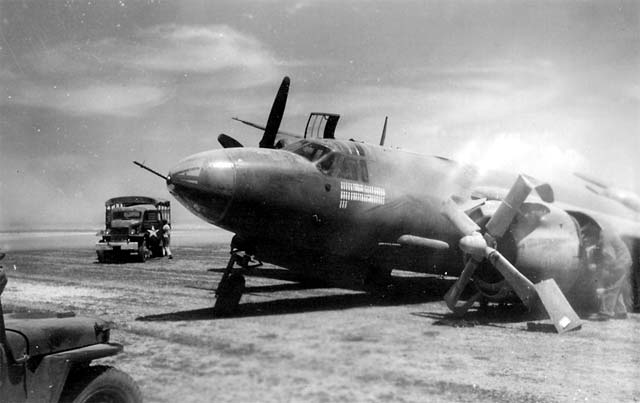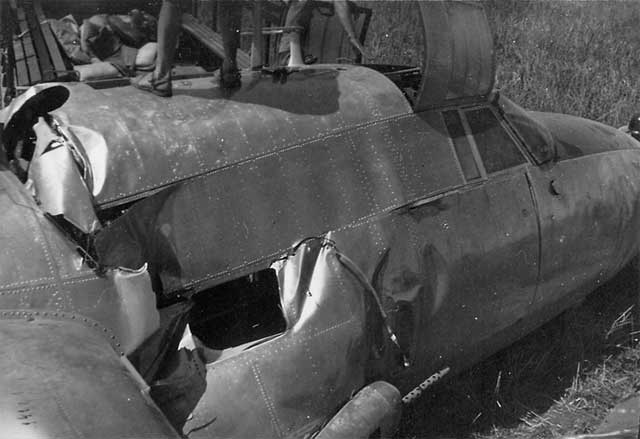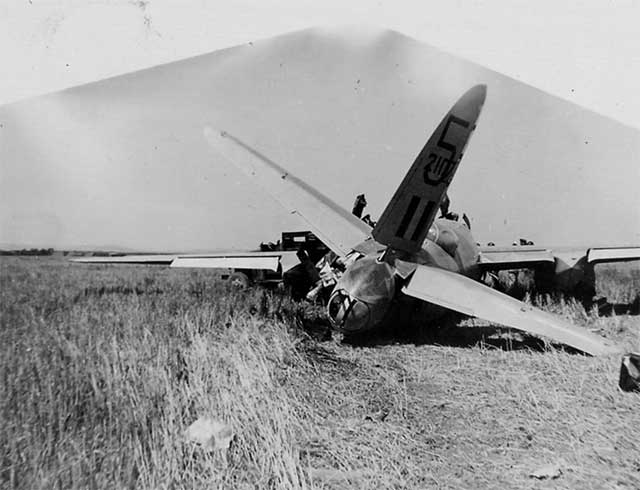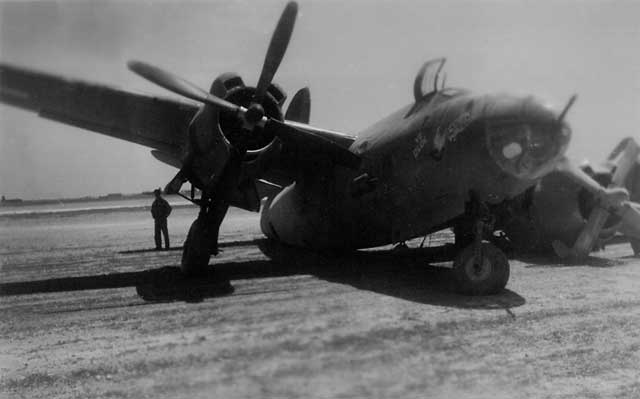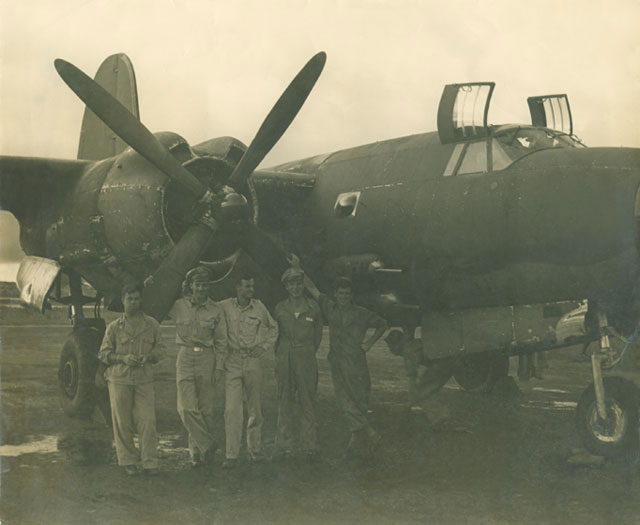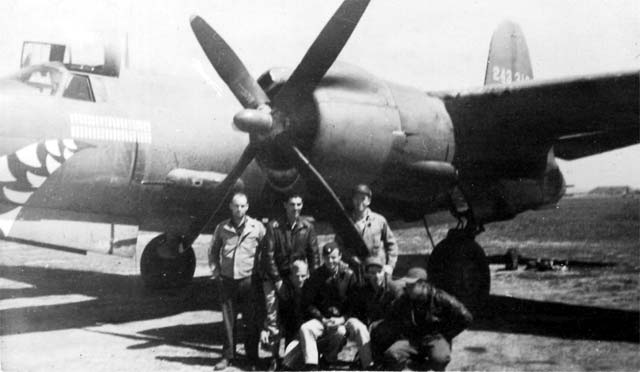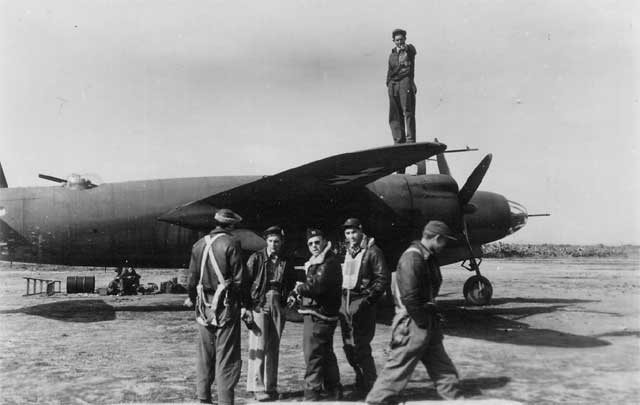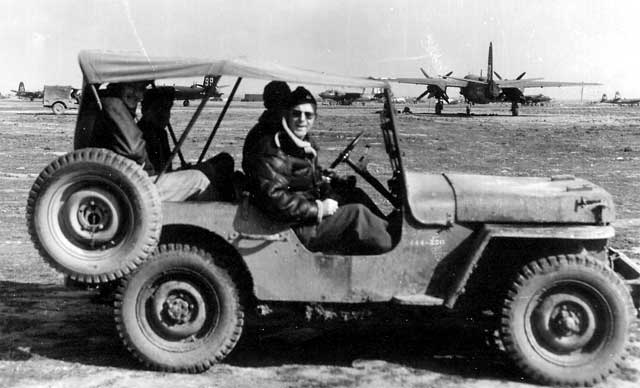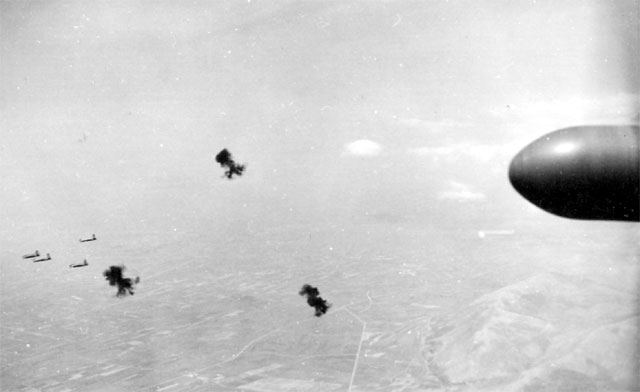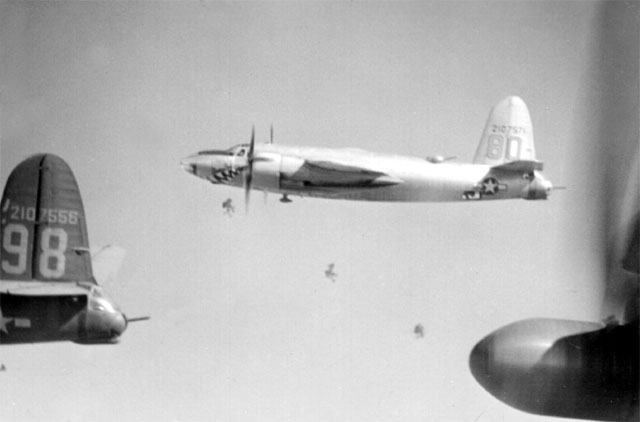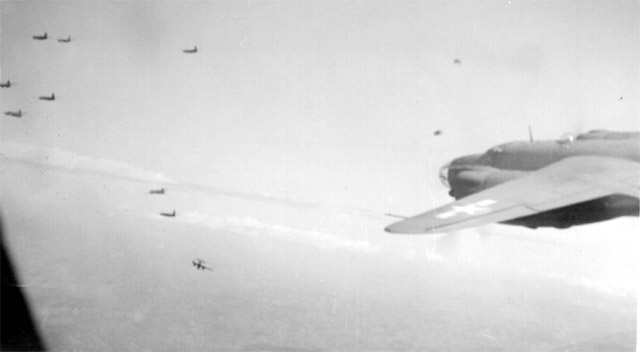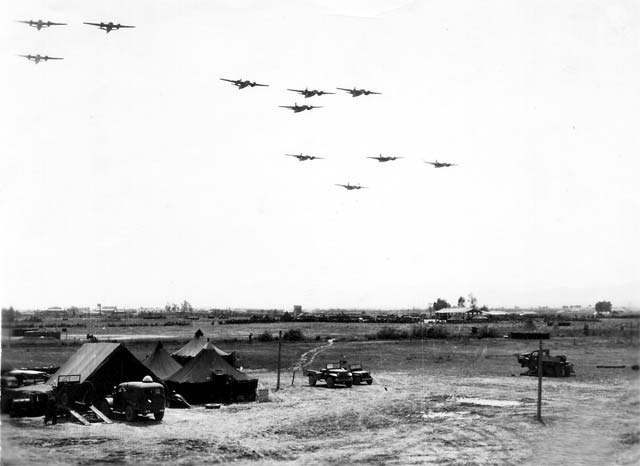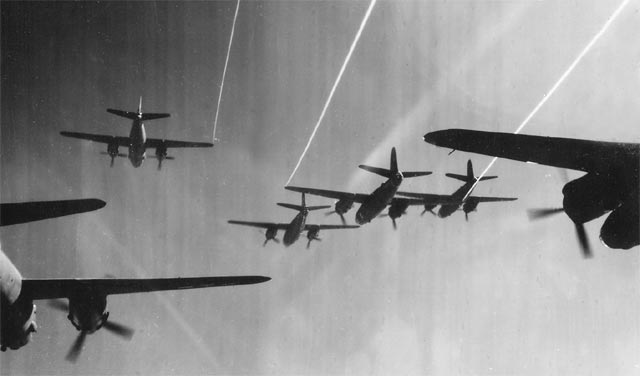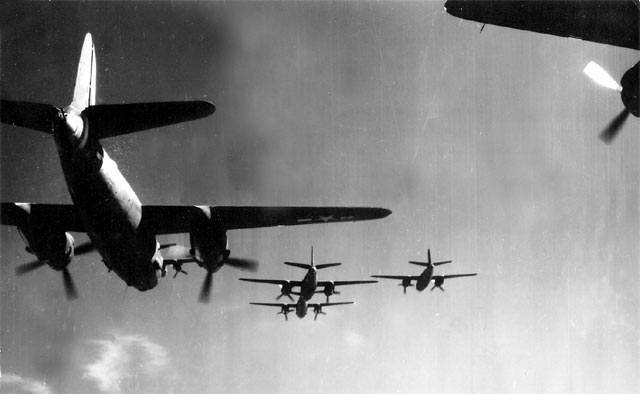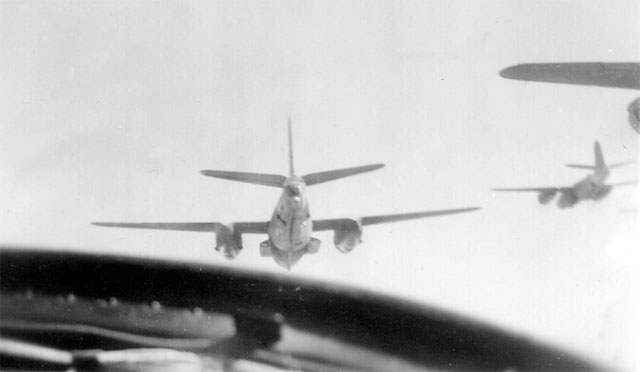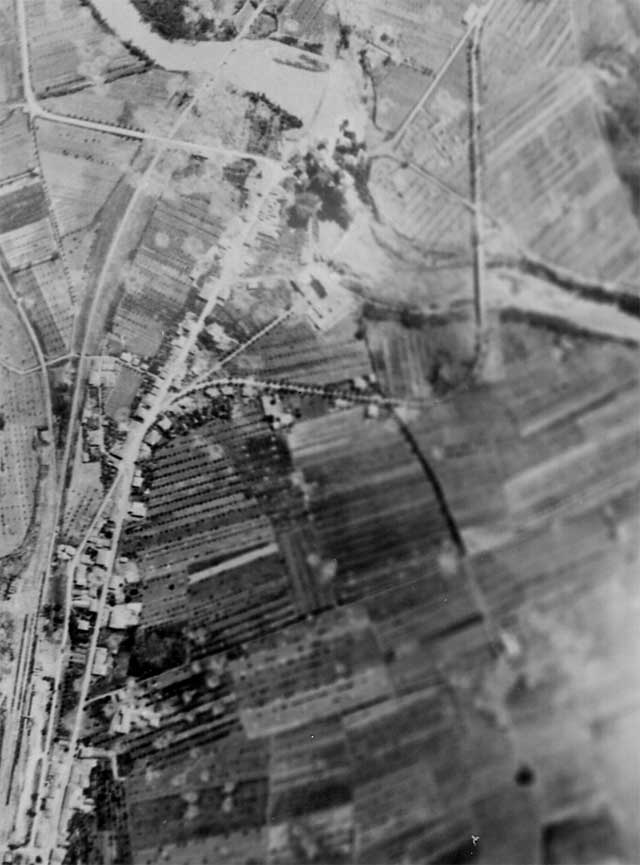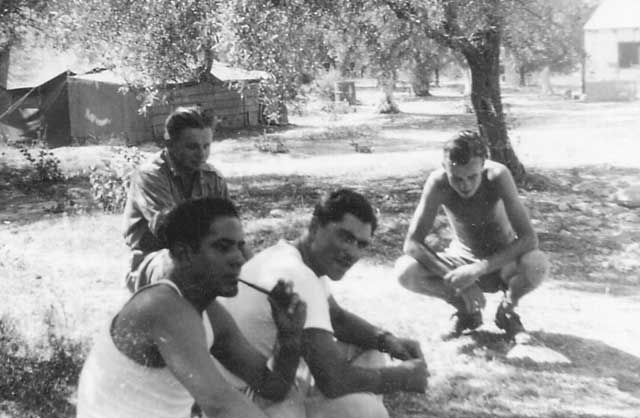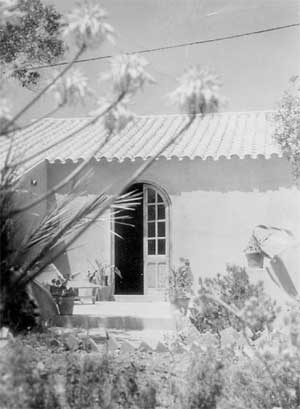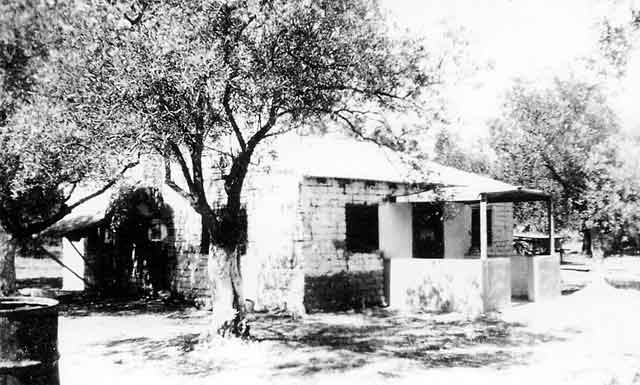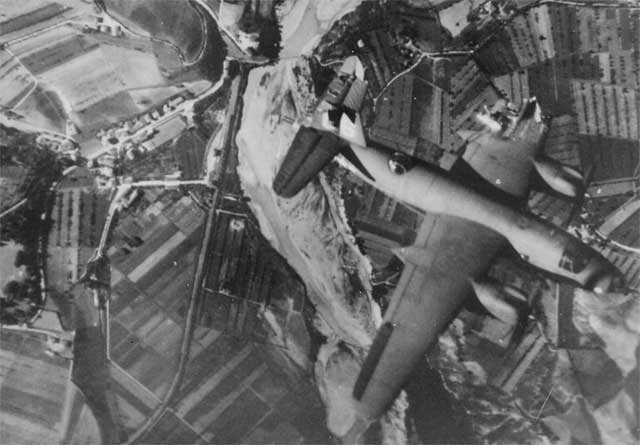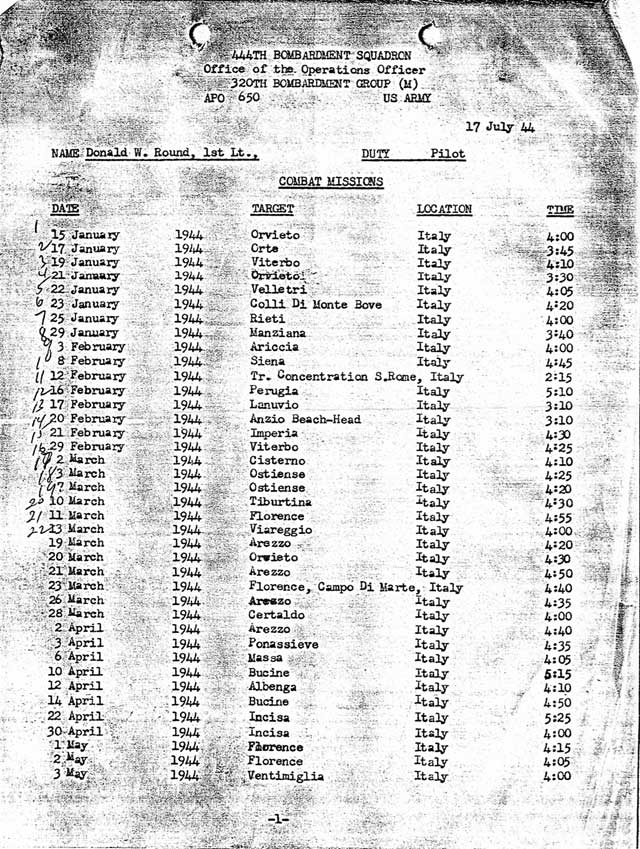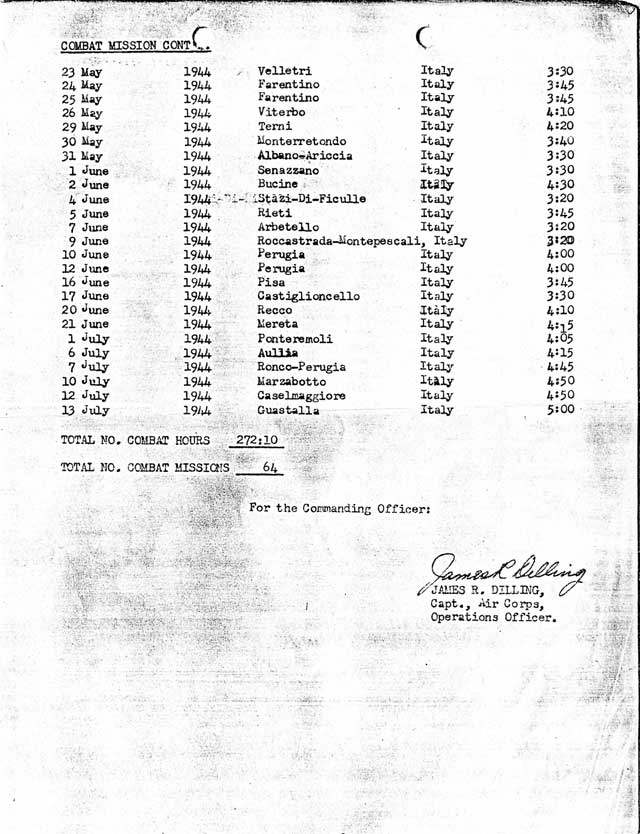|
|
Guest Book | Pages & Links |
Donald Wilson Round, Pilot, Marauder Man
320th BG, 444th BS
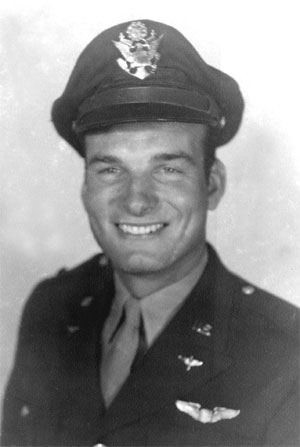
World War II Memoirs
Introduction
I said something about South America to my daughters and they said, "you have never been there", I replied, yes I have during the war. When my daughters were young they were not interested in what I did during the war. I always wished I had asked my father what he did at the Panama Canal, and how he survived the 1900 hurricane and flood in Galveston, Texas.
Training
I am a little different than my brother Arthur (he wanted to be a forester) as far as the war was concerned, I wanted to fly. I spent two years at Bakersfield Junior College in California to get enough credit so the government would pay me to fly. In 1940 President Roosevelt wanted 50,000 pilots trained in case of war so he set up the Civilian Pilots Training Program which I took my second year in college at Bakersfield. I was taking flying lessons at Bakersfield when the war started. While I was there the government created a 150-mile defense zone from the coast, so I had to finish my flying lessons in the Mojave Desert near Mt. Whitney. I earned my Pilots license before I joined the Air Force. Since I was not old enough my sister Mary signed the papers so that I could join the Air Force. I enjoyed my Air Force training, they gave us the best of everything. I had a good time and plenty to eat. My brother and I were a little short on eating for a couple years at Bakersfield. In cadet training, they gave us a dollar a day for meals compared to 21 cents a day for GIs.
I joined the Air Force in Bakersfield and took the test to be a cadet. The test was easy and so was my training in the Air Force ground school. At Bakersfield the night Civilian Pilots Training school was better than what I had in the Air Force, so ground school was very easy for me. We had a lot of time off and San Antonio was a pretty good place to spend it.
After I received my commission, my orders were to report to Avon Park Bombing Range in Florida for B-25 training. When I arrived all they had were B-26s. The B-26s had the name of being "widow makers" and "a plane a day in Tampa Bay". Another pilot that I knew from training reported to headquarters same time I did, the adjutant said "Good to see you, we need an Officer of the Day". We told him we had just graduated from cadet school and we didn't know anything about being an Officer of the Day. He told us, "Well, flip a coin. One of you is going to be the Officer of the Day, see that jeep out there, that Sergeant in it knows what to do". I won the coin toss that time, but I was Officer of the Day twice while I was stationed at Tyndall Field Florida. As Officer of the Day I had to check the stockade to see if all the prisoners were accounted for, this was a first time experience for me. One day I was Tower Officer of the Day and things were going fine until a captain called to tell me I was keeping the P-39 airplanes on the ground waiting for take off too long. I thanked him for the information and told him that this was the first time I had ever been Tower Officer.
My fiancÚ, Charlyne Jane Campbell, came down to Avon Park in August of 1943. We were married in Lake Wales Florida on August 15, 1943, I had to get Lt. Birmingham to fly in my place so I could get married. We had our marriage picture made at Lake Wales, Florida but the studio had to pick out the best one because I was transferred to Elgin Field, Florida for torpedo training. I am glad we never had to drop torpedoes from a b-26 airplane. While at Elgin Field I saw the first B-29 airplane being tested there. It was quite a sight. Next I was transferred to Lake Charles, Louisiana for a short time and then to Savannah, Georgia to prepare to pick up airplane to fly overseas. At Savannah we picked up our equipment made and made checks of our airplane, one such check was a compass check on a piece of railroad tract that ran straight for 21 miles north of Savannah. They gave us south sea equipment one day and the next day they took it all back and gave us equipment for Africa and Europe.
Trip to Sardinia (Crossing the Atlantic)
The trip to Sardinia took 12 days, we stayed in some places a couple of days. We began our trip at Morrison Field, Florida flying to Borinquen, Puerto Rico. They had a good Officer's Club, so we tested out some of their drinks. The next day we followed the chain of islands to Georgetown, Guyana, South America, (the place where the Jones cult religious group committed mass suicide). The next leg of the trip was to Belem, Brazil. We crossed the equator but no one threw water over our heads. The food was not very good in Belem. From Belem we crossed a lot of jungle to Natal, Brazil. The PX at Natal had groucho boots for five dollars so I purchased two pair, which lasted all the time I was in Sardinia and I still had a pair left when I returned from overseas. From Natal we had to fly over 1500 miles to Ascension Island, a small island in the South Atlantic. We needed more gasoline for that leg of the trip so the Air Force installed two 500 gallon tanks in the bomb-bay of the airplane where we would have had four 1000 lb. bombs in combat. There were four airplanes in the our group. We took off into a layer of low thick clouds and it took a few minutes above the clouds to find all four airplanes to head out to Ascension Island. The lead airplane had a navigator, the other three airplane had radio compasses which are good to have when they work, some times the direction needle would just go around and around. The tower at Ascension Island turned on its radio beam when they knew airplanes were headed their way. We were glad to hear their radio beam coming in about one and a half-hours after we left Natal. The needle on the radio compass said come this way; it made us happy to see the compass working right. The lead ship navigator stayed to the left of the beam till we were fifteen minutes from Ascension then he turned on the beam to Ascension Island. The tower at Ascension called us to tell us that the runway was on a bluff about 100 feet above the sea because they wanted to be sure that we came in high enough. The tower told us that a fighter airplane several weeks before came in too low and ended up below the runway. The next leg was to Robert's Field in Monrovia, Liberia. After we had taken off for Ascension Island and were waiting up above for the fourth plane, we saw a big fire in the rocks at the end the runway. The tower called us to tell us that the 4th plane didn't make it. There were very big piles of rocks (40-50 ft tall) at the end of the runway and they did not gain enough altitude to clear them. The two pilots in the airplane were twin brothers.
Africa
From Robert's Field we flew to Dakar, Senegal, which is located on the Western point of Africa. From Dakar we stopped in Tindouf, Algeria in the Sahara Desert. It was too far to follow the coast to Casablanca so we had to fly inland since we could not fly over the Spanish Sahara. I guess they liked Germany too much. From Tindouf we had to fly through the Atlas Mountains which are 18,000 feet high. The B-26 could only fly up to about 15,000 feet and we had to fly through an 11,000 feet high pass. We flew into the pass then changed course again to fly out. We waited about two-hour at Tindouf until the weather was clear in the pass so we could fly through it. The Air Force had a radio operator in the pass to notify Tindouf when the weather in the pass was clear. The runway looked wide enough at Tindouf so we decided to take off in a three ship formation. Everything was going fine until we noticed that the side of the runway we were using was a little short and at the end were some rocks (about 2-3 feet in size). We made a shorter pull up than we normally would have. We thought the tower should have told us about the runway on the left being shorter. I think the tower just wanted to see three bombers take off in a three-ship formation. The weather was clear through the pass. We flew about 350 miles per hour on the down side of the mountains to Marrakech, Algeria., the tower told us to go on to Casablanca, Algeria.
Casablanca
At Casablanca we were told to stay on the steel matting on the runway because there was water on the runway and the sides were muddy. Since Casablanca is located right on the ocean they had a lot of rain. As we landed on the steel matting, it sounded like the airplane was coming apart.
We wondered around Casablanca, later we went to the docks to see all the ships, I purchased some metal designs and a round top hat the natives were wearing, which I still had when I got back to the states. That afternoon we went to a house that was off limits for a steak, which was run by an elderly woman. The steak was so tough that we fed most of it to her small dog that was under the table. She had some good wine, but she would not sell us a bottle. We left the way we came in on a four wheel horse cart. We didn't pay the driver when we got there because we were afraid he might have taken off and it was too far to walk back. One day we took off in order to keep the airplane in shape and to see Casablanca from the air. We saw a B-24 flying around so we feathered an engine and flew about 154 feet from him in the same direction he was going. We didn't stay there long because he was going too slow for us, and we didn't want to stall the airplane. The B-24 called the tower saying there was a B-26 flying near them on one engine. The tower called us to see if we were in trouble, we told them we were just testing our airplane on one engine, the tower said OK. While in Casablanca we looked for Bogart's Club but we could not find it.
We wondered why we were staying in Casablanca so long, but then the rest of our crew showed up by boat. Christmas Day we had a really fine dinner, I drank the coke I had put in my briefcase in Florida. The next day with a full crew we took off for Algiers.
Algiers
We spent the night in transit quarters in Algiers, we slept on rope beds with a blanket underneath us and one blanket on top, I never got so cold in my life. The next day Johnson, the bombardier and I went to town, we wore our 45 pistols on our side. The people kept a good eye on us. The MP's looked at us but passed on by. We found out later that you were not supposed to wear your 45 pistol in town.
In Algiers my friend, Lt. Birmingham, showed up. He was mad because before he landed in Algiers he asked the bombardier how high the mountains were and was told some figure that was not to high. When Birmingham descended though the overcast he saw that there were very high mountains every where he looked. He asked bombardier for the map and realized that the bombardier had misread the map. It was in meters and not feet, which meant the mountains, were almost three times higher than he had been told. If Birmingham had known this he would have made his decent through the overcast over the sea and then flown into the airport.
Sardinia
From Algiers we flew to our base in Sardinia, when we landed a truck picked up our crew and headed up a muddy road, turned into a olive grove to the 444th Squadron Headquarters and we signed in. We were in luck because the base had a bombing alert on Christmas day and no Christmas dinner. They were having Christmas dinner so we had another Christmas dinner. I was assigned a tent with the squadron Intelligence Officer for the night. The Intelligence Officers said all crew officers would have a briefing as soon as possible. The Intelligence Officer wanted to talk about what he did for all four squadrons, he told me he briefed all new officers and then about once a week had a briefing for anyone that wanted to come. He then wanted to know a little about me, also about the trip from Morrison Field, Florida, the southern route through South America and then the ocean crossing to Ascension Island. I told him about the airplane we lost at Ascension Island. He told me they had lost a lot of airplanes on the Northern route through Greenland to England because of bad weather, wrecks and some pilots getting lost over the ocean.
The next day I was assigned a tent with:
1. Arthur Johnson - a former Newspaper photographer from San Diego
2. Robert Pocan, our Bombardier from San Francisco and who had worked in a shoe store
3. Lt. Burke from Washington State, who had joined the Canadian Air force then, transferred to the U.S. Air Force
4. Gasser from Oklahoma
5. And me, from Washington State
We all seemed to get along well. We were all 2nd lieutenants except for Arthur Johnson who was a 1st lieutenant. We attended the new pilot briefing. The intelligence officer showed us maps of everything, such as the Russian Front. He told us about the types of missions that we might fly. We were told to respect the local people, their religion and to stay out of their way when they were having their parades. Coffee and bread was available at the mess hall at all time. Each tent would have to censor the enlisted men's mail at some time. We should get a jeep from the transportation officer and go see the damage done by 320th bomb group to the city of Cagliari, Sardinia, the 320th Bomb Group was stationed in North Africa at that time.
My Missions
I flew my first mission on January 15, 1944 over south Orvieto, Italy the mission was a bridge at on the northern railroad line from Florence to Rome. The group had lost some airplanes over Orvieto and the pilots who had been there before didn't want to go back. The Germans had a lot of guns there and we could see a lot of flak. I flew co-pilot for a very nervous pilot who had lost some of his teeth. He kept calling the tower to see if the mission was cancelled. He must have had a hard time in North Africa. On landing after the mission he overshot the cross wind leg of the pattern and had to come in on an angle to line up with the runway. I never saw him again, I think they sent him home. If I had known how hard it had been for the pilots in North Africa, I would have been nervous too. I flew missions to Anzio beachhead, Florence, Florence again, Rome three times, and Anzio three times, the Po River Valley almost to Germany a couple time, Pisa, and Elba. The rest of the missions were between the Po River Valley and Anzio in the south of Italy. I flew one mission to southern France, but a mistake was made on my mission papers and it is listed as Italy. In the fast 34 missions, I flew my records show that 26 B-26 `s were lost in the our four squadrons for different reasons, some shot down, crash-landings, take offs, damaged from flak, some fell in the ocean trying to get back to home base. I didn't count losses in the next 30 mission I was on. In going back and reading about the missions I had flown, I now see that most of them were more dangerous than I thought at the time.
After returning from my 5th mission, I learned that one of my best friends, Lt. Demetree, had been in a very bad airplane accident on his birthday. On take off, Lt. Meyer was flying first pilot with Demetree as co-pilot. At 300 ft the engines started malfunctioning and before they knew it, the ground was coming up to meet them. They were going down. They were able to miss some big rocks and a ditch. The tail of the airplane broke off and the crew in back were able to get out. Lt. Meyers and Lt. Demetree were able to get out the top of the airplane though the pilot's exit, which was usually locked, but this time was open. They realized that the navigator and bombardier were still inside so they climbed back in and were able to get them out. Once on the ground they were not able to run much so they crawled and were about 100 feet from the airplane when the plane's four 1000-lbs. bombs and a load full of gas blew up. They were very lucky but they were flying again in a couple of missions.
On my 63rd mission, I had a co-pilot whom had just arrived in the squadron and this was his first mission. We had checked the airplane and taken our place on the runway for a three ship take off, we were going about 100 miles per hour when he pointed to the fuel pressure gauge. The needle on the right engine was jumping around pretty bad so I cut both engines off and the co-pilot really jumped in his seat. I applied full brakes, because our position was on the outside in the three ship take off and the runway was long I could do this. I had to get out of the way because there were three ships taking off right after us. I informed the tower of what was wrong and taxied to the take off position. We did a good check on the engines but we could not find anything wrong so I asked the tower for permission to take off. After we were in air it took about 20 minutes before I could catch up to the formation which was about half way to Italy by that time.
On one of our missions we had bad flax and fighters after us., because the flax and fighters had shot up so many of our planes, Col. Fletcher, the flight commander decided to fly to Corsica on the return trip. It had been a long mission and the C.O. gave the rest of the squadron permission to go on to the home base (Decimo) if we had the fuel. Captain Johnson decided to go to Decimo, about 20 miles from the base the right engine quit so I feathered the propeller. We called the tower and they said they would be ready for us. Captain Johnson made a fine single engine landing and taxied to the pad without any trouble.
On one mission as we were returning to the base we were in the mountains when we hit a down draft, I didn't have my safety belt fastened and I my head hit the top of the airplane. I had hair then but it still hurt. The Pilots, Johnson, Burke and myself, in our house were set up to try out three airplanes that had new engines on them. Johnson was the lead pilot; I was flying formation on Johnson and Burke were flying a little above me on my wing. Johnson decided to buzz the squadron. The 444 squadron was located in an olive grove, I had my eyes on Johnson when all of a sudden I could not see him; I was boxed in with Burke flying above me, so I had no choice to but to fly straight-ahead. Johnson airplane was painted an olive color so as soon as we got through the olive grove I could see Johnson again but I was closer to him then I really wanted to be.
Army Food
We had good food while I was there, but of course army food is not always the best, but we always had plenty of bread and coffee. There was always a big can of cheese butter in our tent and sometimes a little wine. At times we could get some canned fruit from the mess Sergeant. We had plenty of eggs to eat, for a package of cigarettes the natives would trade 8 eggs. There is no telling how much money they could get in their country for a package of cigarettes. We could get mixed drinks at the Officers Club about a half block away, our tent had to take turns running the Officers Club. After a mission, the flight surgeon would give us a nip of whiskey. When the liquor got low the squadron would take up a collection of money from the Officers and then the squadron flew a B-26 down to Egypt. In Egypt a bottle of good Liquor cost six dollars, later when I left for home it had gone up to 12 dollars a bottle. Mixed drinks don't taste to good with grapefruit juice but we had to bear it.
One night just about dusk I decided to go down to the tin but where all the squadron cooking was done, in the back they had all the cans of food stored. I thought perhaps the mess Sergeant might have some extra cans of fruit. The mess Sergeant was coming out the front door with a big sack over shoulder, the sack looked like it was full of cans. I said, "Sergeant do you have any extra fruit", he said, "Yes sir, right back on the back shelf you will find some". I thanked him and picked out a can of fruit. When I returned to the front he was long gone. I guess he was going to sell what ever he had in the sack. I am sure I could have made a lot of trouble for him but I just let it pass, he was doing a good job cooking and did not need any more trouble.
One Day I went to a small town to pick up my laundry. I gave the laundry woman some soap which the squadron supplied us for my next laundry. After I paid her she brought out some shirts and pants that had not been picked in about three weeks. I looked at the names on the laundry and they belonged to a captain that had been killed in the line of duty. I told her to keep them for now and I would tell the squadron headquarters about the laundry. I told her I didn't think they would ever come for the laundry. Headquarters said that she probably could use them for material for clothing.
One day another pilot and I were assigned a flight to Naples, Italy to take the 320th dispatches, the other pilot flew as first pilot to Naples. I flew back as first pilot. We checked the weather and set a course for Sardinia. We should have sighted Sardinia in about an hour but we didn't, so I decided to call the Blacktop radar station on Sardinia. We had our radio 1ff signal on for identification, so Blacktop called back and told us to gain some altitude. Blacktop told us to change courses about 90 degree to the north so we did. We sighted Sardinia in about ten minutes. We had corrected for the weather, but the weather must have changed to blow us that far south. I had made the trip several times before and had never had any trouble. If we had stayed on the same course we could have ended up in Spain and spent the rest of the war there.
One night there was a big explosion near the squadron area so the next morning everyone in our house wanted to see what had happened. The Italian Army had an old ammunition dump about a half-mile away so we took off for that area. A pile of old bombs had made a good size hole in the ground.
The Winery
We heard that there was a winery in a small village not far away, so all the pilots from our house decided to find out. The winery had three large barrels of wine so we sampled all three. The wine was cheap so we ordered the smallest they had, a 25-gallon barrel. It was delivered to our house but did not taste as good as it did in the winery. We think they sent a lower grade of wine.
Everything was going fine for awhile and we had a lot of friends come over for samples. One day after returning from a mission the flight surgeon had made a visit to our house, the wine was gone. The flight surgeon asked us to get rid of the wine. When we were off flying missions too many pilots were visiting our house and later could not do their duties. We would do anything that Doctor Conrad asked us to do. He was always on the flight line when missions were taking off and landing. He had gone into one burning airplane and pulled out some crew members.
Hazards of smoking in a Latrine
An unusual thing happened at the Officer latrine. The latrine had two holes and everyday for sanitation purposes a GI would pour a small amount of gasoline into the holes and then set it on fire. On this day the GI after pouring the gasoline down the holes found that he didn't have any matches so he went off to get some. In the mean time a captain went to the latrine, smoked a cigarette, and threw it down the other hole. This resulted in burnt bottom.
Lt. Burke's accident
One evening after dark Lt. Burke entered the house; he didn't look very good, he had an accident on his motorcycle. The natives had dumped a pile of gravel on the roadway, it was so dark he could not see the gravel. Lt. Burke flew over the top of the gavel, but he was able to ride the motorcycle back to the house. He was bruised and his high altitude coat was all in pieces. After he realized that he was better than he first thought he started laughing.
Testing New Engines
Johnson and I take up an airplane for four hours to test its newly installed engines. Lt.'s. Burke, Pocan and. Demettree decided to tag along Lt. Johnson decided to go down to the ocean and buzz the Officers Club. He then headed toward some tall brick smokestacks which were about 100 feet apart. The smokestacks had a cable connecting each at the top, so he thought about flying between them, he gave up and changed his mine. Lt. Burke wanted to fly so I crawled into the nose of the airplane, which is the bombardier's compartment. Lt. Burke decided to fly down a railroad track to see how close he could come to the trees and then headed up into the mountains. He buzzed a small town in the valley and headed up a steep mountain side, I looked back at Burke because I was not sure he would not make it to the top. Lt. Burke just smiled at me then I saw the bombardiers airspeed indicator and we still were going 360 miles/hr at the top of mountain. It was my turn to fly. We were about 10,000 feet when the left engine stopped. I looked back and saw Burke smiling., I knew he had shut the gas off to the left engine so I trimmed the rudder of
the airplane to take the pressure off my left foot. I did not feather the left engine I just let it windmill (let the air turn the prop and engine) so the right engine was pulling the whole airplane. I kept losing altitude to keep the air speed up. After we lost 2,000 feet I told Burke I was not going to feather the left engine till we lost another 2,000 feet so you might as well turn the gas back on the left engine. We all had a good time and at the end of the four hours we went back to the base.
Close formation practice
After I had been at the base about three months Colonel Fletcher decided we that needed more practice in flying close formation. He had all four squadrons flying when they would rather be doing something else. He told us to fly the airplanes much closer together, he had four ships flying almost underneath each other so the two groups of sixteen ships looked like one big group. The gunners had to be very careful when they fired the gun so they would not hit one of our own ships. This close flying paid off the German fighters didn't like so much firepower firing on them. The formation was also harder for the German fighters to break up to attack one ship. It gave the group more protection.
Three Ship Take Offs
We did not practice three ship formation take oils, we just started doing them . We took our positions to the right or left of the lead ship and when we started down the runway we never took our eyes off the lead ship. As soon as the three ships were in the air the next three ships took off. The three ship takeoffs allowed the whole group to form up and head out fast. This resulted in gasoline savings and an increase in range of 70 miles. Our group, the 320-bomber group, used three ship takeoffs while the 319-bomber group which was also at our base used six ship take offs.
Castle
As we were flying around Sardinia from the air we could see some ruins of a old castle, the old castle was not very far away from the base. Lt. Johnson, Lt. Pocan and I decided to go see it. The Transportation officer had a jeep we could use so we gathered up all the gun shells we could fund and then took off. 1 think when the 444th moved from North Africa to Sardinia they loaded all the guns shells, motorcycles and everything else they could get their hands and took it with them to Sardinia. Anytime someone went to North Africa, they brought something back in their airplane.
We drove the jeep about a half-mile from the castle and then climbed up a small hill to the castle. The castle was not very much, just four walls, I think the owner in the old days must not have had much rank. We got a lot of practice with our guns although there was not much to shoot at. On the way back we got the jeep stuck in a little creek so we got our feet wet getting the jeep back to dry land.
Building our House
The war in Italy was going slow and it looked like we would be in the same place for sometime. Some of the other pilots were building houses, so my tent mates and I thought that was a good idea. Materials were easy to get and labor was cheap. We hired three natives to make the mud bricks to dry in the sun. The mud bricks took a lot of water which we took from the area Lister Bag (water bag). This did not the please the GI who had to keep the Lister bag full of water so we gave him something that he needed- Money. We purchased cement in Cagliari and as soon as the bricks were dry we started the house. One night after dark a big truck drove up to where we had started the house with a load of two by fours and big beams we needed for the roof. Lt. Gasser had gone down to the Port at Calgary and some how managed to get truck and driver. We unloaded the lumber and the next day two MPs arrived at 444th Headquarters asking about lumber. The major told them he didn't know anything so they left. The major wanted to keep the pilots happy anyway he could., he remembered how hard living conditions were in North Africa when he was a lieutenant. In North Africa they lived in mud sometime, being one of the first B-26 squadron they had a lot to learn. When our house was finished, it had a nice cement floor with an Air Force star painted in the center, with one big room and a small dark room. At the back we had a storage room for hanging uniforms. The walls were plastered and painted white and we had some real pretty pictures all over the walls. On the side of the house we had a platform about 3 feet high with a 25-gallon tank with 80-octane gas in it. There was a wrecked German stuka airplane in a field, which had tubing on it. We needed the tubing to run a gas line inside our house to a stove, which we made out of an oil drum. On the stove we had a good valve set for a slow drip of gas. The drip made a little noise when it hit the bottom of the stove but it heated the house. Later we had to use 100-octane gas because the squadron's gas dump was running short of 80-octane gas. We hired a man who helped make the mud bricks for our house, he asked if he could keep the house clean. It was nice to have someone to make your bed and pick up any mess we made. He took our laundry to the laundry woman and did anything else we might need. This sounds like we might have been lazy, but everyone who built houses had the same deal.
Lt. Johnson had been a photographer for a San Diego paper so he knew what we needed for a dark room. We were able to get all the supplies we needed from the base photo lab. We were able to get long rolls of film about twelve inches wide and three inches thick. I made an enlarger from tin from a bomb case which fit on the back of Lt. Johnson's good camera which worked fine. We could not use the enlarger until nightfall when they turned the lights on. The big light bulb in the enlarger took a lot of electricity, this sometimes caused the lights in the squadron to dim so headquarters would send someone down and tell us to turn it off.
We cut a lot of film into the sizes we needed in our dark room; we borrowed a hacksaw from transportation but had to go easy with the hacksaw because it produced static electricity on the film. We furnished a lot of pilots with film if they had the paper backing from their old film.
Trip Home
July 14, 1944 was one of my lucky days. That afternoon while we were enjoying some coffee in our house. Headquarters sent word down for me to be prepared to leave for Naples. After completing 64 missions. I was scheduled to be sent back to the US. I was the first in the 444th squadron to have that many missions except for some 444th squadron officers at Headquarters. When I first arrived pilots were sent home after 40 missions, then the Air Force changed the requirements and left it open-ended. They would not tell you how many missions you had to fly. This made the older pilots very mad so they sometimes just took it easy and let the younger pilots fly instead. I asked the operations officer to put me down to fly, because I wanted to get the missions in.
A visiting captain who was in our house when I received my orders asked me how much I would take for my area of the House he was tired of living in a tent. The house cost about $1200 to build so we all thought $300 was a fair price. The captain showed up the next day with the money. The squadron moved to Corsica two months later so he got a good deal for his money.
There was not much to do at the 7th Repell Center in Naples where we waited to be sent home but to check the board every day to see if we were on order to go home. My last day there I visited The University of Naples. It sits on a high bluff where you can see the Isle of Capri. I could see hundreds of boats of every kind. I was sure that they were ready to invade Southern France. We learned two days later that they had landing in Southern France.
We boarded one of five boats set to take us back to the USA. They assigned us a nice stateroom. The only problem was there were 12 officers in one room. All the bottom bunks were taken so I had a top bunk. That first night they served a very fine meal, but it was to rich for me and gave me some trouble, after that the meals were ok, We visited the PX during the day and if you were there at the right time you could get some good candy bars.
The trip home took fourteen boring days, but the weather was pretty good. No one that I know of became seasick. On the last day we saw the Statue of Liberty. Two tugboats came out to meet us and opened the submarine gates so we could get into the harbor. We boarded a truck that took us over to Camp Kilmer in New Jersey. A night and a day later a train took us Camp Shelby at Hattiesburg, Mississippi. We were given a 10-day pass at Camp Selby and coupons for new shoes. By midnight I was on a bus to Jackson, Mississippi. I was able to get on the second section bus to Tallulah, Louisiana where I could change busses for Pine Bluff, Arkansas. Unfortunately at Tallulah, the bus for Pine Bluff did not wait for the second section and there was not any more busses or trains for Pine Bluff for fifteen hours so I tried hitchhiking. Luckily an Army major on his way to Pine Bluff picked me up.
Lucky
One might think if you have read my tour of duty that I had an easy time, I would say that I was very lucky. I did have an easy time during my tour of duty. My training was very easy for me, it was an interesting trip through South America and Africa and we had no troubles. When I arrived at the base in Sardinia, joined the 444th Squadron which turned out to be a very friendly squadron. All the officers at the 444th squadron headquarters had been in North Africa where things were very bad at times so they had lot of experience. Some of the pilots had built an Officer's Club so they were always trying to make life more pleasant if they could. One would never know that they were in the Air Force except for flying duties, I never got cold and had plenty to eat and after we built our house we had a very nice living.
I was able to fly. I told the flight commander I would fly first pilot or co-pilot because I wanted to get my missions in. Several times I flew 7 mission in seven days so the missions started to add up. In 10 months, I flew 64 missions. I was the first one in the squadron to go home after the Air Force set the limit of missions at sixty-four.
On many missions the flak was very accurate and the gunners spent a lot time shooting at enemy fighters. The flak made many holes in the airplane. One mission while we were flying over the Island of Elba one bullet hit the dash broad of the airplane and another bullet made a hole in a self sealing wing tank. If the bullet had been a tracer bullet it might have blown the wing off. Once I watched the crew of an airplane jump out of their airplane into the ocean where the water was so cold you would be lucky to live for five minutes. Another time I watched two airplanes. One was shot up heading for home and in the other airplane, we could see some of the crew moving around, so we tried to make radio contract but failed. The airplane just blew up. I was on a lot of dangerous missions. I sometimes think I was too young and too dumb to worry about them. I have a picture of a B-26 with one wing gone, it happen to fall under a B-26 that happened to have a camera that was taking pictures of something on the ground.
I flew one mission to Anzio, Italy on the first day of the invasion. About 20 miles over the ocean we could see a fighter airplane coming out to meet us, head on. A very short distant from us it turned to the left. It was a German fighter, it didn't fire at us and no one in our 36-ship formation fired at it, later no one ever mention it.
All I can say is that a lot of my friends are dead from doing their duty; sometimes one is in the right place and survives while others are not so lucky.
